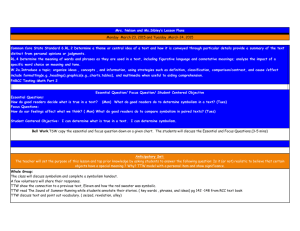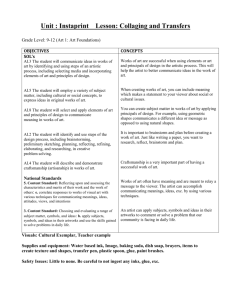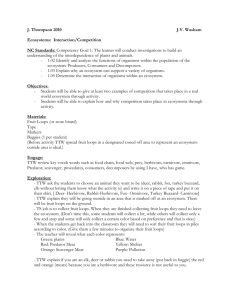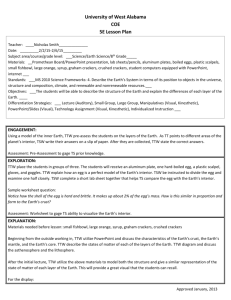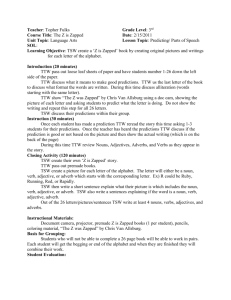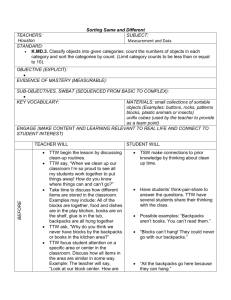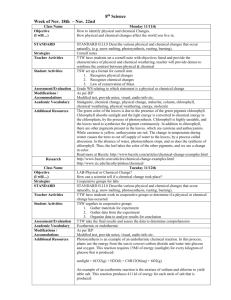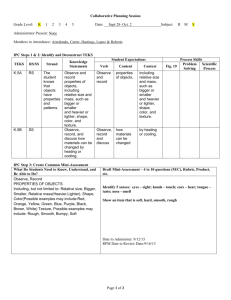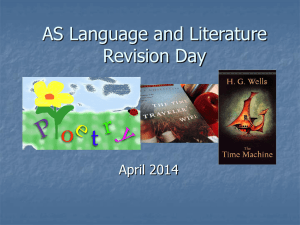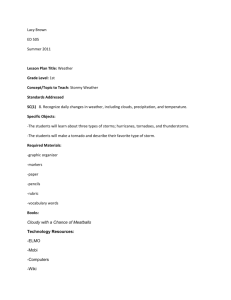ED_448_Ecosystems_IL
advertisement
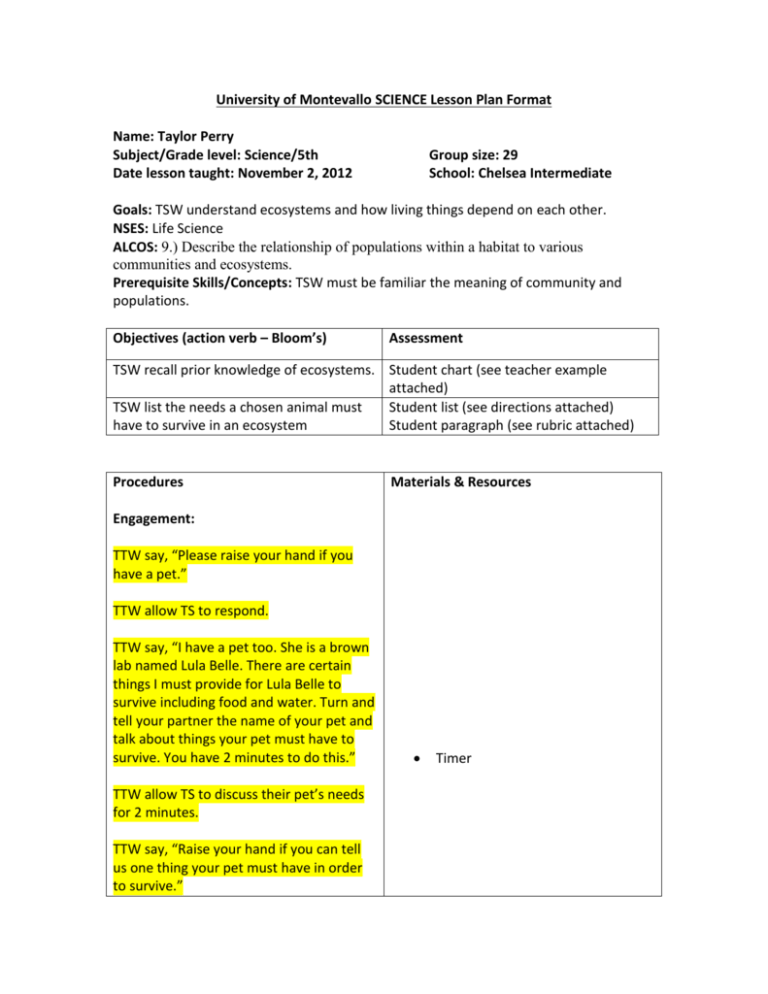
University of Montevallo SCIENCE Lesson Plan Format Name: Taylor Perry Subject/Grade level: Science/5th Date lesson taught: November 2, 2012 Group size: 29 School: Chelsea Intermediate Goals: TSW understand ecosystems and how living things depend on each other. NSES: Life Science ALCOS: 9.) Describe the relationship of populations within a habitat to various communities and ecosystems. Prerequisite Skills/Concepts: TSW must be familiar the meaning of community and populations. Objectives (action verb – Bloom’s) Assessment TSW recall prior knowledge of ecosystems. Student chart (see teacher example attached) TSW list the needs a chosen animal must Student list (see directions attached) have to survive in an ecosystem Student paragraph (see rubric attached) Procedures Materials & Resources Engagement: TTW say, “Please raise your hand if you have a pet.” TTW allow TS to respond. TTW say, “I have a pet too. She is a brown lab named Lula Belle. There are certain things I must provide for Lula Belle to survive including food and water. Turn and tell your partner the name of your pet and talk about things your pet must have to survive. You have 2 minutes to do this.” TTW allow TS to discuss their pet’s needs for 2 minutes. TTW say, “Raise your hand if you can tell us one thing your pet must have in order to survive.” Timer TTW allow TS to respond and will make a list on the ELMO. ELMO Notebook Paper Pen Purpose: TTW say, “These are all very important things that our pets must have to survive. Today we are going to learn about ecosystems and how living things or organisms depend on other living and nonliving things to survive.” Explore: TTW say, “Take out your Science journal and turn to the Table of Contents. Add ‘How Living Things Depend on Each Other’ to your Table of Contents then turn to the next clean page and title it ‘How Living Things Depend on Each Other’.” ELMO Notebook paper Pen Science Journals Pencils ELMO Notebook paper Pen ELMO Notebook paper Pen TSW fill out the Table of Contents and title the next clean page in their science journals as TT models it on the board. TTW say, “In the top right corner, write your name and today’s date. Now draw a line down the middle of the page and make a T-Chart like the one I am drawing on the ELMO.” TTW model each step for TS and allow TS time to title their page and draw a T-Chart. TTW say, “Label the left side of your TChart What We Know, and label the right side of your T-Chart What We Want to Know.” TTW model this for TS on the board and allow them time to finish labeling their charts. TTW say, “An ecosystem is a community of living organisms which includes living and nonliving things. In an ecosystem, organisms depend on each other to survive. I want you to take the next 3 minutes to write down everything you know about how living things depend on each other. When the timer goes off, put your pencils down and put your eyes on me.” Timer TTW walk around and monitor TS as they write down everything they know about how living things depend on each other. When the timer goes off, TTW say, “Now I want you to take 2 minutes to write down what you want to know about how living things depend on each other. When the timer goes off, put your pencils down and put your eyes on me.” Timer TTW monitor TS as they complete the right side of their T-Chart. When the timer goes off, TTW say, “Raise your hand to tell me one thing you already know about how living things depend on each other.” TTW call on TS and allow them to respond. TTW will record student responses on the T-Chart displayed on the ELMO. ELMO Pen TTW say, “Raise your hand to tell me one thing you want to know about how living things depend on each other.” TTW allow TS to respond and will record student responses on the T-Chart displayed on the ELMO. TTW say, “Now we are going to look at a picture of a riverbank environment which is an ecosystem composed of many ELMO T-Chart Picture of Riverbank different organisms. Please put your eyes on the board and pay close attention.” TTW display the picture on the ELMO and say, “There are a number of different organisms pictured in this riverbank environment. In a minute I am going to assign you a partner. I want you and your partner to choose one living or nonliving thing and make a list of things your organism needs to survive. Do this on the next clean page in both of your science journals. Each of you will write down your list in your science journal.” ELMO Pencils Predetermined partners TTW call on a student and say, “Will both of you write the list in your science journals?” TTW allow TS to respond. TTW say, “Everybody must write their list in their science journal. You have 5 minutes to make your list. You may work anywhere in the room but when the timer goes off, return to your seats, close your science journals, and put your eyes on me.” TTW pair TS and display the directions and the list of partners on the board. Timer Directions on board Pairs on board TTW monitor TS as they discuss their chosen organism’s needs and create a list. When the timer goes off TSW return to their seats. TTW say, “Listen closely as I explain our next activity. In a few minutes we are going to go to the outdoor classroom. You and your partner must work together to find one thing that your chosen organism will need to survive. You will have 5 minutes to find your item. Make sure you take your science journals Timer Science Journals Pencils and a pencil. Here are the rules: 1) There is absolutely no running. 2) It is okay if other people choose the same item. 3) When the timer goes off, you must immediately place your object back where you found it and meet at the gate of the playground. 4) You must stay within sight of your teachers. Are there any questions?” TTW allow TS to ask questions about their activity. TTW remind TS to be quiet in the hallways and lead TS to the playground to allow them to search for objects that relate to their organism’s survival. Before TS begin looking for their items, TTW say, “You are to find one item that your organism needs to survive. Write the name of the item and why you chose it in both of your science journals. When you are finished, line up along the fence outside of the outdoor classroom. You have 5 minutes, you may begin.” After timer goes off, TTW say, “Make sure both you and your partner are here with the rest of the class. Do not talk to other groups, we will have time to share in the classroom. We need to be extremely quiet on the way back to the classroom because other students may still be working in their classes. Let’s make sure that the school knows how the best class in the school walks to the classroom! Quickly and quietly! If you have anything in your hands that belong outside, you need to make sure that it does not come inside the school.” Timer TTW lead TS back to the classroom. Explain: TTW let one student from each pair of students quickly stand up and explain the object that they chose and why. After TS return to the classroom, TTW say, “Now that we have been outside and looked at different items our organisms might need to survive, do you think your organism could survive here at our school? Turn to the next clean page in your science journal. Write one paragraph that is at least 5 complete sentences long describing what your organism needs to survive and whether you think it could survive here at Chelsea Intermediate. You have 10 minutes to write this. When the timer goes off, write your name on your paper, tear it out of your journal and turn it into the Science drawer.” Evaluate: TTW circulate around the room to monitor student responses and will discuss with TS why their organism could or could not survive at Chelsea Intermediate. When the timer goes off, TTW allow TS to ask questions about today’s lesson. Possible student questions: Are human’s a part of an ecosystem? Do animals die when humans pollute? Closure: When the timer goes off, TTW ask TS the following questions: What is an ecosystem? Timer Science Journals Pencils Do all organisms need the same things to survive? What do you think will happen if someone builds a city near the riverbank environment we looked at earlier? TTW call on TS to respond. TTW use observation of student responses to ensure students understand the meaning of ecosystems and how organisms depend on each other to survive. Student responses will also demonstrate their ability to make predictions about what how living things affect the ecosystem. Extend: TTW allow TS to draw their organism’s ecosystem in their science journals. TS must also explain why they drew each aspect of the ecosystem in a paragraph consisting of 3-5 sentences. Accommodations: ELL/ESL students will be allowed to use GOOGLE translate to look up alternate definitions of words like organism and ecosystem for their science journals. Hard of hearing students and/or students who have sight problems will be allowed to sit up front during class. Modifications: According to each individual IEP. Extensions: TS will be allowed to use the back of the paper in their science journals to draw their organism’s ecosystem and explain why they drew each aspect in a paragraph. References: National Science Foundation (2004). Science and Technology for Children: Ecosystems (2nd ed.). Burlington, NY: Carolina Biological Supply Company. http://newhavenscience.org/4STCEcoLesson1.pdf How Living Things Depend on Each Other What We Know What We Want To Know Directions 1. Work with your partner to choose one organism from the picture of the riverbank environment displayed on the board. 2. Make a list of items the organism must have to survive. 3. When the timer goes off, return to your seats quickly and quietly, close your science journals, and put your eyes on me. Organism’s Survival Rubric Criteria Clarity: The student thoroughly expresses his or her thoughts clearly by using evidence and examples to support his or her claim. 5 4 Rating 3 2 Completeness: The student writes a paragraph consisting of 5-7 sentences and includes the name of the organism, the items it needs to survive, and why it could or could not survive at school. 5 4 3 2 1 0 Neatness: The student’s handwriting is neat and legible. 5 4 3 2 1 0 Accuracy: The student uses knowledge of how living things depend on each other to explain why the organism can or cannot survive at school. 5 4 3 2 1 0 Total Points: Comments: 1 0 Taylor Perry ED 448: Methods and Materials for Teaching Science November 7, 2012 Journal Article Review Discovery-based instruction must be enhanced or used with other methods of instruction for it to be effective in an elementary classroom. Both explicit and discoverybased instruction methods were proven to be effective in this study, but only when teachers use other means of instruction to supplement the lesson. Although discovery learning seems to effectively engage students throughout lessons, the hands-on activities do not always ensure that the students are learning the material. Alfieri, Brooks, Aldrich and Tenenbaum (2011) stated that discovery works best when students select important information, organize it, and integrate the information into a “task-appropriate way.” However, this can be very demanding of students in elementary school. The students must learn how successfully complete each step of the discovery process in order to be successful in discovery learning. Although direct instruction proves to be more effective for adolescents, it is important to provide students with opportunities to apply new knowledge and discover what strategy or method works best for them. Students will learn more when they are given the chance to ask questions and receive feedback than when they are being lectured and taught explicitly without the option to give their opinion. It is important to implement explicit instruction strategies as well as discoverybased learning methods in order to ensure student learning. In the fifth grade classroom that I am observing in this semester, my students are excited when they are given the option to participate in hands-on activities. Because they are a gifted cluster class, they love to be challenged, and I believe discovery-based instruction gives them the chance to explore different ideas and prove that their methods are correct. The science lesson that I created for my class implements a form of discovery-based instruction that I believe was effective with my students. They seemed to be engaged the entire time I was teaching because I did not explicitly teach how living things depend on each other to survive. When the lesson started, the students felt like they did not possess the background knowledge necessary to make connections. However, after a lot of discussion and teacher prompting, they started making connections that I was really impressed by. After a long discussion about how living things depend on each other, I asked the students to choose one organism from a picture of a riverbank environment. The students were then instructed to compose a list of items their organism needs to survive. After creating this list, I took them outside where they were to find one item that their organism could use to survive at their school. The students loved being allowed to go outside, and came up with very creative ideas. I then had them apply what they learned during the lesson to write a paragraph about whether their organism could survive at school based on the availability of items needed to survive. My students thoroughly enjoyed every second of the activity and turned in really thoughtful paragraphs about their organisms. Although discovery learning was effective in this lesson, I feel that explicit instruction may be better during lessons that require the students to learn new strategies. As teachers, it is our job to use best practices, even if it means using a multitude of strategies and methods. References: Alfieri, L., Brooks, P. J., Aldrich, N. J., & Tenenbaum, H. R. (2011). Does Discovery Based Instruction Enhance Learning?. Journal Of Educational Psychology, 103(1), 1-18.
